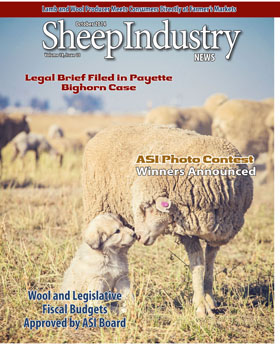
- October 2014
- President’s Notes
- ASI Team Represents Industry in Nanjing
- Belt Buckle Commemorates ASI’s 150th Anniversary
- Colorado Youngster Constructs Lego Camp in Honor of Family Heritage
- Commentary: Recent Headlines Are Example of Public’s Misunderstanding of Protection Dogs
- Dan Wilson: The Best Lamb Marketer is Usually the Person Who Raised the Lamb
- Grazing Allotments, Bighorns Take the Stage at Public Lands Council Meeting
- Market Report
- Nomination Deadline for Annual ASI Awards: Nov. 15
- Opening Brief Focused on Forest Service Payette Errors
- Sheep Budgets for 2014 Approved by Board
- Sheep News in Brief
- Working Together to Make Sheep Better
Grazing Allotments, Bighorns Take the Stage at Public Lands Council Meeting
IGNACIO, Colo. – Sheep industry leaders expect grazing allotment decisions by Region 4 of the U.S. Forest Service to be announced sometime in February of 2015.
Losing allotment acreage due to the ongoing bighorn sheep issue has been the focus of ASI and state sheep associations, and became a topic during September’s Public Lands Council annual meeting in Colorado.
“We had a lot of discussion on bighorns during the meeting and we made clear where the sheep industry stands on the issue,” said Peter Orwick, ASI’s executive director. Orwick attended the PLC annual meeting with Jim Richards, ASI’s Washington, D.C. representative.
“If sheep grazing is to be moved, the only fair way to treat American ranch families is to provide viable alternative country to keep the ranch operational,” said Orwick. “The framework plan for forests in Wyoming, Utah, Idaho and Nevada was written collaboratively with the Western Watersheds Project, a legal activist group that is dedicated to removing all livestock from federal-land use.”
This year’s PLC meeting featured discussion on other hot-button issues, such as potential sage grouse listing under the Endangered Species Act; the federal wild horse and burro program; the Clean Water Act; and local government participation in federal land use planning.
Other topics of interest to sheep producers were talk on the proposed closing of the U.S. Sheep Experiment Station and PLC assisting ASI and state sheep associations in the battle to keep the sheep station open.
“The station is likely the perfect place to research interface issues between livestock and wildlife, therefore, the department ought to support it, not abandon it,” said Orwick.
PLC Executive Director Dustin Van Liew said this year’s meeting helped set some priorities for the next several months and years.
“Our board of directors approved five new projects to research and bring more awareness to the benefits of utilizing public lands for grazing,” said Van Liew.
Earlier this summer, A bi-partisan letter signed by 37 U.S. Senators and Representatives was sent to U.S. Agriculture Secretary Thomas Vilsack and the Bureau of Land Management (BLM), asking for clarification of plans to avoid damage to sheep ranches that could be forced out of business due to the loss of allotments.
The upcoming decision by the Forest Service is expected to affect a number of ranches and sheep businesses that graze sheep on public lands.

